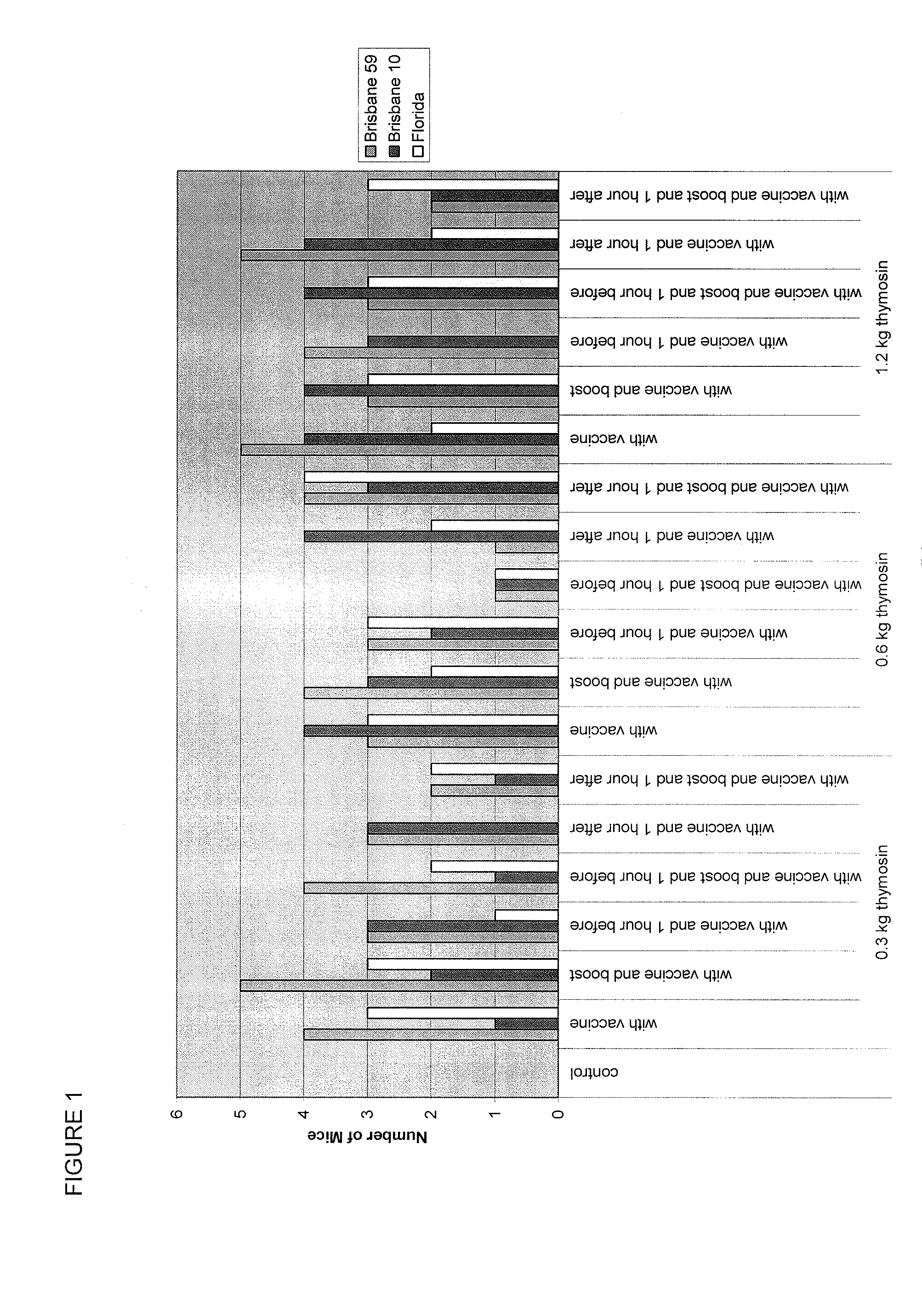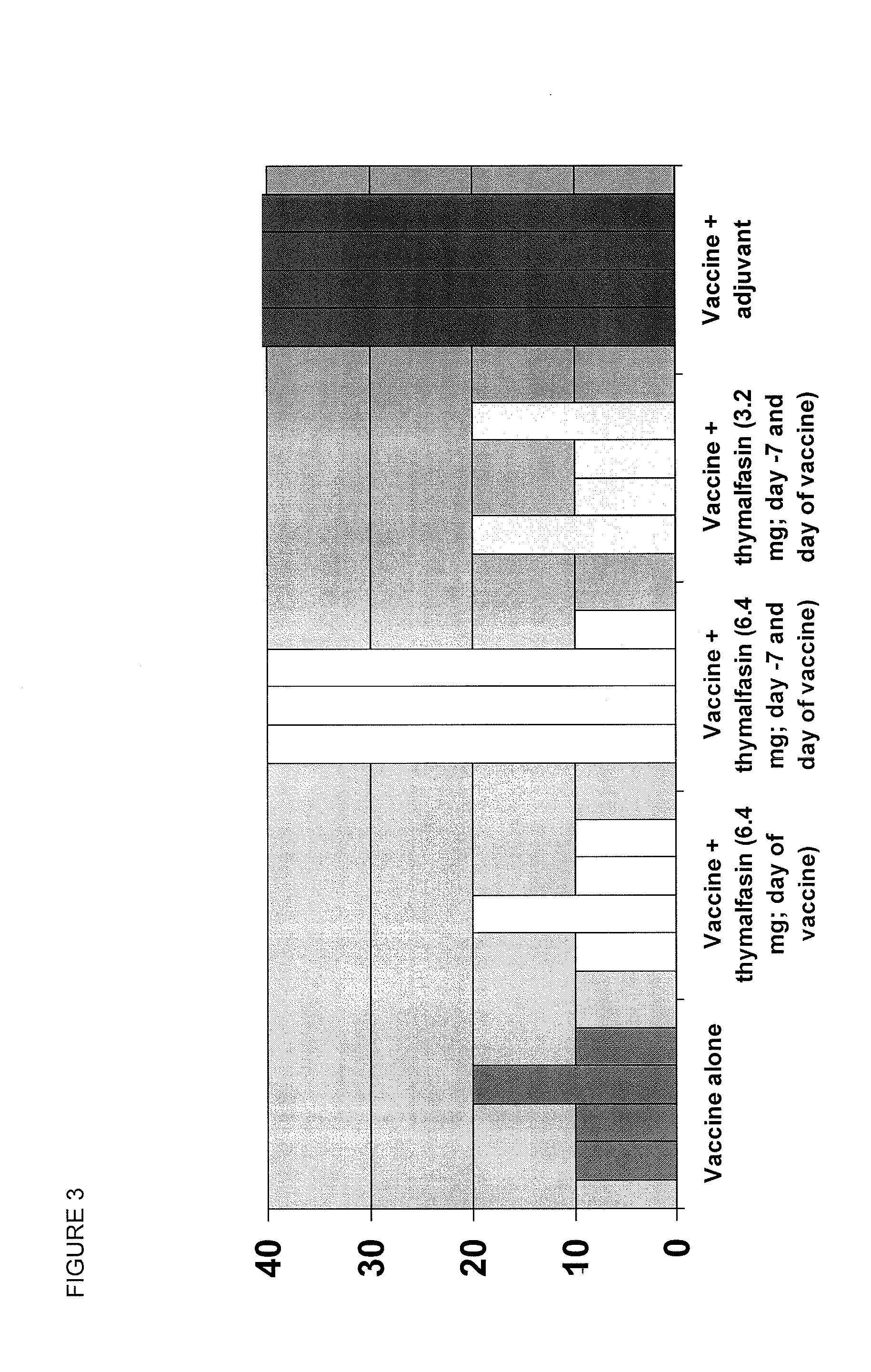Alpha thymosin peptides as vaccine enhancers
a technology of alpha thymosin and enhancer, which is applied in the field of alpha thymosin peptides as vaccine enhancers, can solve the problems of many immune responses quenched and reduced vaccination effectiveness, and achieve the effects of enhancing vaccine effectiveness, enhancing vaccine effectiveness, and enhancing vaccine effectiveness
- Summary
- Abstract
- Description
- Claims
- Application Information
AI Technical Summary
Benefits of technology
Problems solved by technology
Method used
Image
Examples
example 1
Enhancement of H1N1 Vaccination in Mice
Summary
[0096]A study was conducted to determine the potential of TA1 (thymalfasin) to enhance the formation of anti-influenza antibodies in CD-1 mice following different vaccination schedules with the seasonal influenza vaccine Fluvirin® 2008-2009. The mice received either control article or vaccine on Study Days (SDs) 1 and 10 or SDs 8 and 17. The mice also received different doses of TA1 at different times in relation to the vaccine administration. Both the control article and vaccine were administered via intramuscular injection to both the right and left hind limbs; TA1 was administered by the intraperitoneal route. All mice were given a fixed dose of control / vaccine regardless of the body weight. The mice were observed twice daily for mortality, moribundity, general health, and signs of toxicity; body weights were recorded prior to dosing. Blood samples were collected on either SD 20 or 27 (ten days after final vaccine administration) and ...
example 2
Enhancement of H1N1 Vaccination in Ferrets
[0116]Thymosin has been shown to exert immunomodulation in several microbial and tumor settings by a variety of mechanisms which include potentiation of antibody responses. In the efforts to control the ongoing influenza pandemia caused by the new A / H1N1 virus of swine origin, a voluntary, mass vaccination will be implemented in most countries, and vaccines with or without adjuvants will be used. At least some of these vaccines will require a post-1 month booster dose to induce appreciable production of virus-neutralizing antibodies in most vaccinees. Moreover, the availability of these vaccines for the whole target population is doubtful. It is therefore important to assess whether suitable doses of thymosin, administered separately but concomitantly with the influenza vaccine may potentiate the antibody responses to the virus.
experimental study
[0117]Influenza-free ferrets are very responsive to influenza virus, and thus can be used to test protective anti-virus effects. In the experiments, potentiation of vaccine immunogenicity was tested using both an adjuvanted influenza vaccine (Fluad: as a control) and non-adjuvanted influenza vaccine (Agrippal, labeled simply “vaccine” in the Table below).
[0118]5 groups of 4 ferrets received control article or vaccine on SD 0 (vaccine) and 21 (boost). TA1 administration occurred as indicated in Table 5. The proposed thymosin dosage was deduced with reference to published data in mice and humans, and taking into account the weight of the ferret. A pre-bleeding checked the negativity of anti-influenza titer.
[0119]The vaccine (either Agrippal influPozzi seasonal vaccine, non-adjuvanted, or Fluad, MF-59 adjuvanted) was administered via intramuscular injection to the right leg at a full human dose of 0.5 mL. TA1 (0.285 or 0.570 mg / kg / dose) was administered by the subcutaneous route at a d...
PUM
| Property | Measurement | Unit |
|---|---|---|
| time | aaaaa | aaaaa |
| time | aaaaa | aaaaa |
| time period | aaaaa | aaaaa |
Abstract
Description
Claims
Application Information
 Login to View More
Login to View More - R&D
- Intellectual Property
- Life Sciences
- Materials
- Tech Scout
- Unparalleled Data Quality
- Higher Quality Content
- 60% Fewer Hallucinations
Browse by: Latest US Patents, China's latest patents, Technical Efficacy Thesaurus, Application Domain, Technology Topic, Popular Technical Reports.
© 2025 PatSnap. All rights reserved.Legal|Privacy policy|Modern Slavery Act Transparency Statement|Sitemap|About US| Contact US: help@patsnap.com



